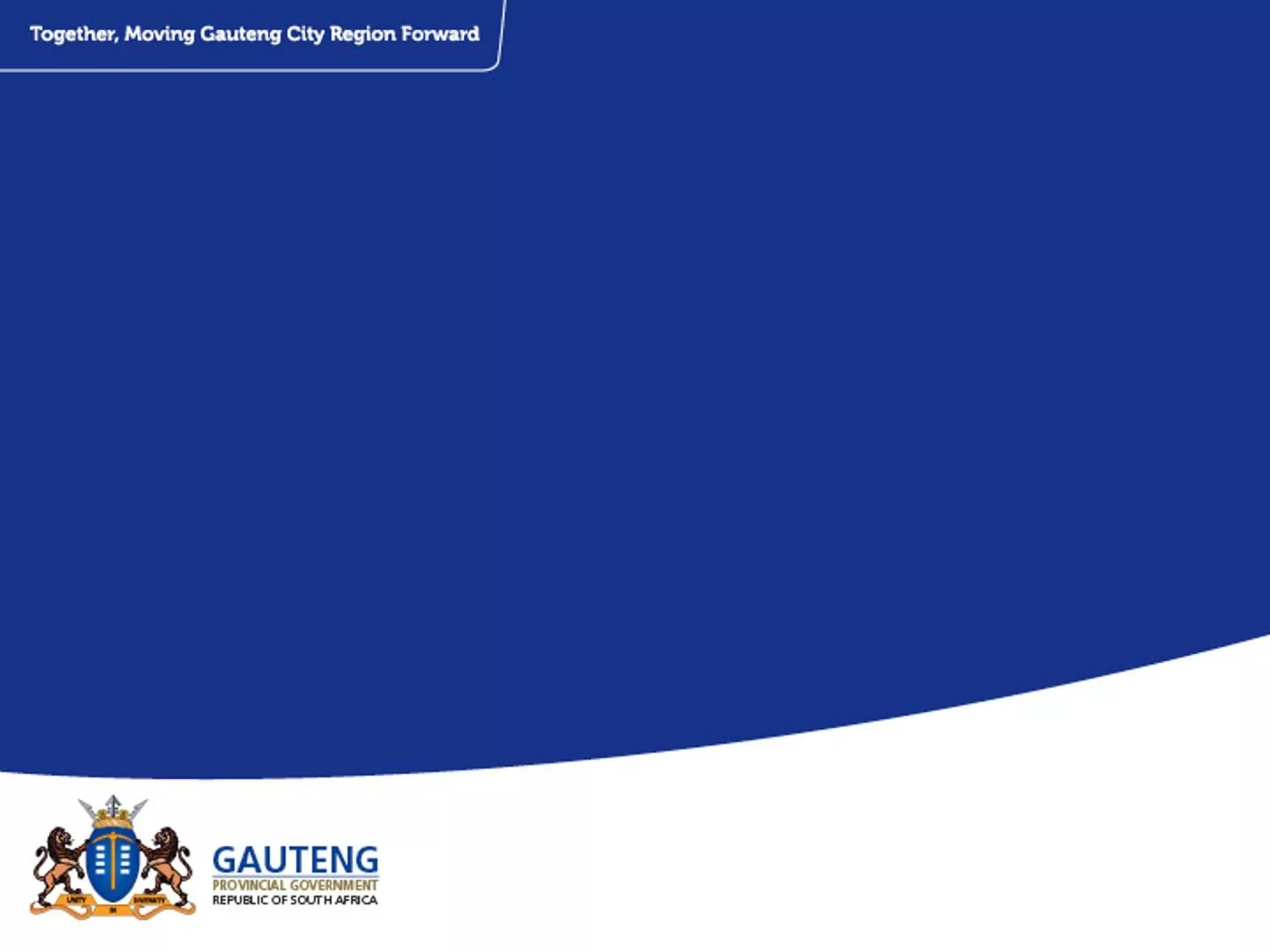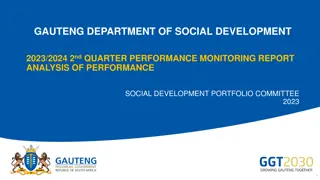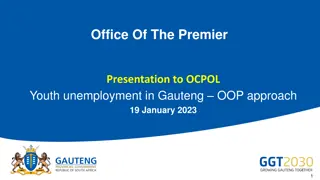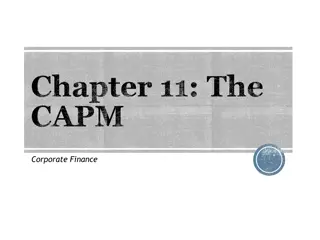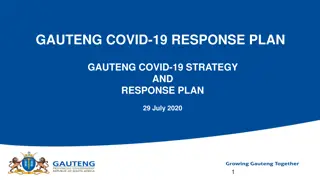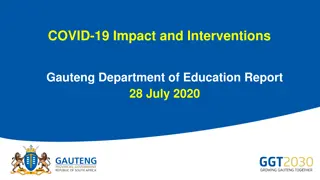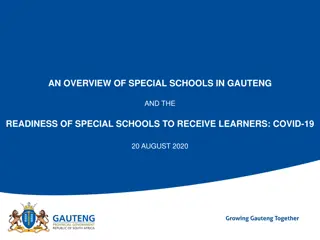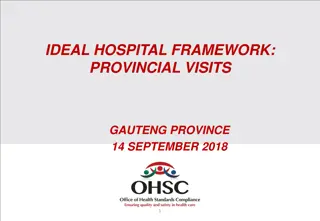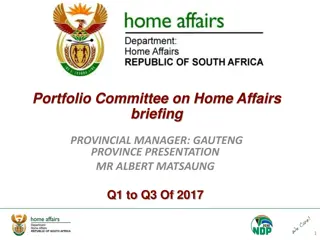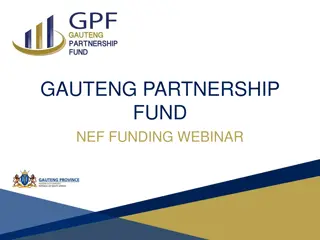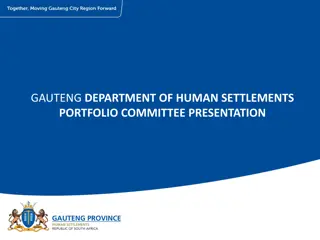Gauteng Department of Education Portfolio Overview
The Gauteng Department of Education is committed to providing functional and modern schools to ensure quality teaching and learning for every learner. The department's strategic planning aims to align policy with budgets, focusing on common goals and outcomes. Long-term and medium-term planning frameworks, such as the National Development Plan (NDP) 2030 and the Medium-Term Strategic Framework (MTSF), guide the department's programs and initiatives.
Download Presentation

Please find below an Image/Link to download the presentation.
The content on the website is provided AS IS for your information and personal use only. It may not be sold, licensed, or shared on other websites without obtaining consent from the author. Download presentation by click this link. If you encounter any issues during the download, it is possible that the publisher has removed the file from their server.
E N D
Presentation Transcript
Gauteng Department of Education Portfolio Committed Round Table Discussions 6 February 2018 1
Vision and Mission Vision Every learner feels valued and inspired in our innovative education system Mission We are committed to provide functional and modern schools that enable quality teaching and learning to protect and promote the right of every learner to quality, equitable and relevant education.
Overview The executive authority is responsible for developing a five year vision which should guide the development of the department's strategic plan. The aim of strategic planning is to bridge the gap between policy and budgets; Strategic planning must ensure common purpose between the executive authority and the accounting officer in the pursuit of government objectives and outcomes. Strategic plans must form the basis for identifying departmental programmes. The MEC in consultation with the Premier and EXCO has agreed on the key goals and objectives for the five years and has signed a performance agreement
Planning, monitoring and reporting system 5th Administration has adopted long, medium and short- term planning Long- term planning National Development Plan (NDP) 2030 The TMR programme expresses the NDP in the GCR context Emphasis on radical socio- economic and spatial transformation in the period to 2030 and beyond Sectoral long- term plans Gauteng Integrated Transport Plan, Gauteng Infrastructure Master Plan, Revised Gauteng Spatial Development Framework.
Planning, monitoring and reporting system Medium- term planning - Priorities over the electoral mandate period 2014 to 2019 National: Medium Term Strategic Framework (MTSF) Building- block for the implementation of the NDP Consists of 14 outcome areas Forms the basis for the National Delivery Agreements Provincial: Gauteng Medium Term Strategic Framework Based on Ten Pillars of TMR, and Local government priorities Departmental: Five- Year Strategic Plans Based on Gauteng MTSF and national MTSF, sectoral and programme priorities
Planning, monitoring and reporting system Short to medium- term planning GCR- wide plan: Programme of Action (POA) Translates TMR priorities into measurable programme Annual, rolling outcomes- based plan with quarterly targets and annual targets for outer years Financial allocations Departmental plans: Annual Performance Plans (APPs) Sets out what departments intend during the upcoming financial year and MTEF to implement the strategic plan Includes performance indicators and targets for budget programmes and sub- programmes
Planning, monitoring & reporting instruments POA linked to other instruments but distinct approach & purpose Game changers Short- term priorities e.g 100/ 200 days MTSF Gauteng POA Strategic Plans Departmental APPs
Planning, monitoring & repor8ng instruments Outcome plans for each of the Ten Pillars Sector- based Inter- governmental Province- wide Annual rolling MTSF Strat plans (5y) POA Mul8- s ectoral Inter- governmental Province- wide Financial & non- financial Annual rolling with targets to 2018/19 IDP/ SDBIP Mul8- sectoral Localised Mul8- sphere APP Sector- based Province- wide Single sphere Annual
CONTEXT AND VISION GDE s 10 pillars for education transformation The Department s plans are underpinned by the Ten Provincial Pillars, with the key focus on Pillar 3: Accelerated social transformation and a supporting role in all the other pillars. GDE s 10 pillars for education transformation 1 2 Radical economic transformation 1. Curriculum Development and Assessment Decisive spatial transformation 3 4 Accelerated social transformation Transformation of the state and governance 2. Teacher Provision and Support 3. Leadership and Management 4. Infrastructure Development and maintenance 5 6 Modernisation of the public service Modernisation of the economy 5. Planning, finance and resourcing 6. ICT in Education 7 Modernisation of human settlements and urban development 7. Social Cohesion 8 Modernisation of public transport infrastructure Re-industrialisation of Gauteng province Taking the lead in Africa s new industrial revolution 8. School functionality including community Involvement 9 9. Skills Development 10 10. Access to quality Early Childhood Development (ECD)
Strategic Framework for 2015-2020 Planning, finance and resources Support from Parents Social Cohesion Post Schooling Training and Education Curriculum and Assessment Development Teacher Provision and Support Learner Performance grades 3, 6, 9, 12 Make Schools Attractive Effective classroom Practice Leadership and Management Improved Learner Attainment School functionality including community involvement ICT in Education Infrastructure Development and maintenance Access to quality Early Child Development (ECD) Partnerships
2015-2020 5-YEAR INDICATORS OVERVIEW The approved GDE 5 year Indicator Framework comprised of 60 indicators: 36 constituted Programme Performance Measures (PPMs or sector/national measures); 24 were Specific Performance Measures (SPMs or Provincial MTSF measures) In 2015/16 the sector introduced 42 statistical indicators which included many or most of the MTSF indicators this was discontinued except for 13 assessment and exam related indicators.
2017/18 APP INDICATORS OVERVIEW The approved GDE 2017/18 Annual Performance Plan comprised of 73 indicators: 1. 36 constituted Programme Performance Measures (PPMs or sector/national measures); 2. 24 were Specific Performance Measures (SPMs or Provincial measures), and; 3. 13 constituted Statistical Technical Indicators (STIs). The Indicators as approved are tabulated below: No. Programme PPMs SPMs STIs Total 4 3 0 7 1 Administration 9 8 0 17 2 Public Ordinary Schooling 3 2 0 5 Independent Schools Subsidies 3 3 2 0 5 Public Special School Education 4 2 2 0 4 5 ECD 10 2 0 12 6 Infrastructure 5 5 13 23 7 Exams & Related 36 24 13 73 TOTAL
2017/18 Revised APP with MTSFs Indicators The HEDCOM Sub-Committee meeting held on the 24 February 2017, took the decision that all PEDs would include the previously-omitted MTSF indicators in their 2017/18 APPs. It was further agreed that the PEDs that did not include the MTSF indicators in their approved 2017/18 APPs would need to incorporate them in their revised 2017/18 APPs. The GDE incorporated 19 MTSF indicators across 3 programmes that were not previously included in the approved 2017/18 APP (see table below) - Programmes 3, 4, 6 and 7 were not impacted No. Programmes No. of MTSF Indicators 4 1 Administration 14 2 Public Ordinary Schooling 1 5 ECD 19 TOTAL
2018/19 APP INDICATORS OVERVIEW The approved GDE 2017/18 Annual Performance Plan comprised of 73 indicators: 1. 36 constituted Programme Performance Measures (PPMs or sector/national measures); 2. 24 were Specific Performance Measures (SPMs or Provincial measures), and; 3. 13 constituted Statistical Technical Indicators (STIs). The Indicators as approved are tabulated below: No. Programme PPMs MTSF Total 4 4 8 1 Administration 9 14 23 2 Public Ordinary Schooling 3 3 Independent Schools Subsidies 3 3 3 Public Special School Education 4 2 1 3 5 ECD 10 10 6 Infrastructure 5 5 7 Exams & Related 36 19 55 TOTAL
Good performance indicators should be: Reliable Must be accurate enough for its intended use and respond to Well defined Clear, unambiguous defini5on so that data will be collected consistently and will be easy to understand and use changes Verifiable Possible to validate the processes and systems Cost- effec5ve Usefulness of the indicator must jus5fy the cost of collec5ng the data Appropriate Avoid unintended consequences and encourage service delivery improvements Relevant Must relate logically and directly to an aspect of the ins5tu5on's mandate
SMART performance targets Nature and required level of performance can be clearly iden1fied S PECIFIC Required performance can be measured EASURABLE M Realis1c given exis1ng capacity A CHIEVABLE Required performance is linked to achievement of goal R ELEVANT Time period/deadline for delivery is specified T IME BOUND
Audit criteria Main criteria Sub- criteria Compliance with regulatory requirements Applicable to performance management and repor5ng Presentation Measurability Relevance Consistency Usefulness Validity Reliability Accuracy Completeness 21
Preparing for the Audit Understand and test the design and implementation of the performance managementsystems, processes and relevant controls 1 Test the measurability, relevance, presentation and consistency of planned and reported performance information 2 Confirm on the usefulness of the reported performance information for selected programmes or objectives 3 Test the reported performance information against relevant source documentation to verify the validity, accuracy and completeness of reported performance informa5on 4 Conclude onthe reliabilityof the reported performance for selectedprogrammes or objectives 5
Audit reporting Auditors report REPORT ON OTHER LEGAL AND REGULATORY REQUIREMENTS Predetermined objec1ves Usefulness of informa1on Material audit findings focusing on presenta5on, consistency, relevance and measurability of reported performance informa5on for selected programmes or objec5ves Reliability of informa1on Material audit findings focusing on reliability of reported performance informa5on for selected programmes or objec5ves Compliance with laws and regula1ons Compliance findings relevant to the performance management and repor5ng
Preparing and addressing the MTSF The Department s planning officials was part of the DBE team in formulating and specifying the MTSF indicators. The Department agreed to all of the MTSF indicators, except, requesting that Technical Indicator Descriptors be amended for the following 4 new MTSF indicators: PPM 211: Number of teachers who have written the Self-Diagnostic Assessments PPM 212: Percentage of teachers meeting required content knowledge levels after support. PPM 214: Number and percentage of Funza Lushaka bursary holders placed in schools within six months upon completion of studies or upon confirmation that the bursar has completed studies. PPM 219: Number and percentage of learners who complete the whole curriculum each year. The Department also requested the Auditor General to audit all the new MTSF indicators for readiness but not deliver an audit opinion on them.
Preparing and addressing the MTSF Department has: Workshopped all Branch Managers , Chief Directors and Direct Line Managers on the 19 new MTSF indicators and the related Technical Indicator Descriptors (TIDs). Business processes has been developed for all the new MTSF indicators. The business processes will be used to develop standard operating procedures and define the AoPo Line managers have been notified to be audit ready
Preparing and addressing the MTSF Historical data was gathered for all the indicators and targets was set the for the 2017/18. The 2017/18 targets is used as a baseline for 2018/19 planning cycle. The 2017/18 Annual Performance Plan has been revised to include the MTSF indicators. With TIDs developed by the Department The 2018/19 Annual Performance Plan is in its final draft and includes all MTSF indicators With TIDs developed by the National Department
Challenges related to the MTSFs Indicators Technical Indicators Descriptions (TIDS) were not clear/precise on some of the indicators this required an extensive refinement process to facilitate the introduction of the MTSF indicators into the approved 2017/18 and 2018/19 APPs. Setting of targets in light of the non-availability of historical data. Lengthy consultative process both nationally and provincially (GDE Line Managers) to prepare for the successful introduction of the MTSF indicators. The full introduction of the MTSF indicators without a prior pilot phase imposes a significant reporting obligation on provinces. The absence of a policy framework for some of the MTSF aligned PPMs may hinder the development of effective standard operating procedures.
SYSTEMS DEVELOPED ,CHALLENGES AND RISKS IDENTIFIED
Performance pressure points Cabinet Auditing Ministry Civil Service Agency Commissions Department Parliament Citizens Front Line Finance Evaluation Units Planning The primary use and benefit of performance information resides within Government ministries & departments for management purposes. Actors external to this environment exert pressure for accountability and control.
System and Policy Implications System integrity for accurate and reliable reporting takes two to three years to establish. As such the data integrity for the new PPMs in year one and year two is at risk of a negative audit opinion. GDE s current systems related to some of the MTSF indicators are not sufficiently robust for the capture, storage and retrieval of data which runs the risk of generating a weak evidential base. The absence of a policy framework for some of the MTSF aligned PPMs will hinder the development of effective standard operating procedures. Pre-existing GDE and MGSLG & Sci-Bono systems, processes and procedures related to introduction of the MTSF indicators were not sufficiently robust for the capture, storage, retrieval, analysis and reporting of data this raises some concern about the reliability of both the target setting and reporting against the new indicators
Challenges The GDE is likely to experience reporting challenges in respect of the following indicators: PPM205: Learner absenteeism rate It is difficult to manage standard operating procedures at school level to confirm the accuracy, validity and completeness of the reported learner absenteeism rates at schools. PPM 211: Number of teachers who have written the Self- Diagnostic Assessments The implementation of the self-diagnostic process was postponed by DBE No policy appears to underpin the process teachers (Unions) may argue that it is not compulsory to write the test. PPM 212: Percentage of teachers meeting required content knowledge levels after support we need to verify whether the reporting standard of teachers obtaining 80% in their content knowledge scores is grounded in any normative framework.
Challenges PPM 214: Number and percentage of Funza Lushaka bursary holders placed in schools within six months upon completion of studies or upon confirmation that the bursar has completed studies. The reporting period is not definitive The placement period potentially could straddle 2 financial periods and this may generate some confusion An example will be do we report on 2014 graduates in the 2015/16 financial year, if we report in the 2014/15 financial year we can only report achievements up to the last quarter of 2014/15. The indicator implies that we should report up to the end of the second quarter in the financial year, hence reporting over two financial years. PPM 219: Number and percentage of learners who complete the whole curriculum each year. The completion of the entire curriculum would require robust in- school and departmental monitoring systems. This deliverable has multiple dependencies grounded in the availability of suitable, reliable and relevant resources at all levels of the system
Recommendations related to the New Indicators The Education sector and DPME need to formalize an agreement with the Auditor- General that will allow for the new PPM s to be audited solely to determine the state of readiness to accommodate the new indicators and not to confirm an audit opinion in the 2017/18 and 2018/19 audit cycles. The PPMs have been adopted and will be implemented however the final audit outcomes in respect of all newly adopted PPMs should have been postponed until all the PEDs reached some level of confidence and comfort in becoming audit ready.


